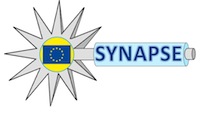
|
| HOME |
| SCIENTIFIC BACKGROUND |
| PROJECT OBJECTIVES |
| DISSEMINATION |
| NEWS |
| CONSORTIUM |
| CONTACT PERSONS |
| SYNAPSE ON EC-CORDIS |
| RESTRICTED AREA |
| Coordinator |
| Massimo Longo |
| Tel:+39-039-6035938 |
| email: |
| Laboratorio MDM |
| CNR-IMM, Unita' di Agrate Brianza |
| Via Olivetti, 2 - 20864 |
| Agrate Brianza(MB) - Italy |
The "SYnthesis and functionality of chalcogenide NAnostructures for PhaSE change memories" (SYNAPSE) project aims to increase the storage capacity per cell, and reduce the power consumption and cost of nonvolatile memories by using industry-compatible techniques (MOCVD) to form nanoscale chalcogenide-based memory cells. We foresee the successful MOCVD deposition of chalcogenide NWs and their functional analysis, using the expertise of the consortium.
The first goal of the SYNAPSE project is to undertake a detailed study of the growth processes and functional properties of Ge-Sb-Te and In-based nanowire systems.
In particular, the self-assembly and selective growth approach for the final production of NWs will be adopted, along with MOCVD. For the MOCVD of phase change materials, featured by limitations related to deposition temperatures and adsorption of metalorganic precursors on dielectric substrates, the selection of proper reactants (precursors) will be carried out, along with the implementation of specially designed precursor delivery methods (bubblers, sublimators, etc.). On one hand, metallic nanoparticles (catalyst seeds) will be used on flat or structured substrates, to induce 1D growth under the vapor-liquid-solid (VLS) mechanism; this process is expected to deliver free standing NWs. On the other hand, substrates patterned by lithography will be employed for selective area growth (SAG) development, leading to the self-assembly of free standing NWs only in unmasked areas where the growth is allowed.
The SAG technique is expected to provide ordered arrays of NWs. In the case of the VLS techniques, NWs will also be deposited into patterned substrates containing nanohollows with a catalyst at their bottom, in order to induce the NW formation by MOCVD.
The second goal is to optimize the NW characteristics for the data storage application. The research will focus on the investigation of functional properties of the NWs, including the phase change mechanisms and their dependence on the NWs size, structure and chemical composition. Experimental work will be supported by theoretical modeling and simulation which will aid the selection of the best performing materials/geometries to be used into the NWs.